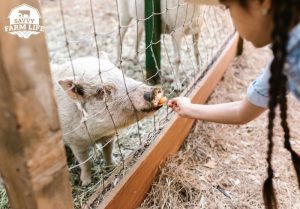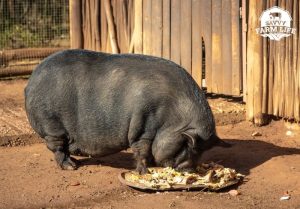
Can Pigs Eat Anything?
Pigs are famous for being the garbage disposal of the farm. They will happily consume your healthy, home-cooked leftovers with a helping of cow manure on the side. Pigs eat without abandon and discrimination. Indeed, they must have a rockstar of a digestive system.
How is it that pigs can eat almost anything? Unlike their pasture pals, pigs are omnivores, meaning they eat both animal products and plant matter. Pigs are also opportunistic feeders and will eat almost anything they deem edible. While the pig’s biology does not make them any more resistant to food-borne illnesses, they are hardy animals due to the high rate of pathogens they are exposed to from a young age.
While you may be excited to own pigs and actually get some use out of leftovers, just because a pig will eat almost anything doesn’t mean they should be fed everything. This article will cover the pig’s digestive system and proper pig nutrition.
Pig Digestive System
When talking about what pigs can and can’t eat, it is essential to first understand the pig’s digestive system. Most grazing farm animals are polygastric (ruminants), with three or four stomach chambers. However, like humans, pigs are monogastric (non-ruminants), meaning they have just one stomach. While pigs and humans share this similarity, a pig’s stomach is three to four times larger than a human’s stomach.
Proper Pig Nutrition
It is vital to provide adequate nutrition when raising pigs for meat consumption (or as pets, for that matter). While pigs are happiest free-ranging or on pasture, a pig cannot forage enough to completely meet his caloric or nutritional requirements. Nor can he get all of the protein he needs from pasture alone. Remember – pigs are monogastric, unlike their polygastric livestock friends. They are not designed to live on grasses alone.
It is recommended to feed your pig a grain-based commercial feed explicitly formulated for pigs. Most pig feed is corn-based, and not only because of the wide availability of inexpensive corn. Corn is easily digestible and is a good source of carbohydrates for pigs.
In addition to feed, it is perfectly acceptable in most regions to supplement your pig’s diet with food scraps. This can be in fruit rinds, vegetable peelings, cooked meat scraps, hard-boiled eggs, or milk and cheese. You can also give your pigs the occasional treat of bread or pastry – be warned, however, that some have reported bread to cause an uptick in pig manure stench. While some pig farmers feed their pigs their raw meat trimmings, this is not recommended. Feeding a pig raw meat can unintentionally transfer a trichinae parasite that will then reside in the pig’s muscle tissue and transmit to humans through consumption.
I specified that it is acceptable to feed scraps to your pigs in most regions because this may not be the case in every country. In Australia, for example, it is illegal to provide commercial pigs with both meat products and food scraps. These bans are often a result of an infectious outbreak, such as African swine fever or foot-and-mouth disease. If you are raising pigs for market, make sure you check with your local ordinances to determine whether there are feed restrictions in place.
Pigs Will Eat Anything Edible
Pigs are opportunistic omnivores, just as their ancestral wild boar are. Wild boar eat both plant matter and animal matter. Their diet consists mainly of plant matter, including roots and acorns in the wild. A smaller percentage consists of animal products – mainly in the form of fresh or picked-over carcasses. This behavior did not change when pigs were domesticated, and many pig farmers take advantage of that. Most pig farmers feed their pigs food scraps and other items that would otherwise end up in the landfill. The pigs enjoy the scraps, the farmers can save a small percentage on feed, and the environment ultimately benefits as well.
Food isn’t the only thing pigs need to survive. To get a complete rundown of the things you’ll need to raise pigs, visit my article What Do Pigs Need? Top Pig Supplies You Need.
What Do Wild Pigs Eat?
Wild pigs eat a diet rich in plant matter, including grasses, weeds, tubers, roots, acorns, and mushrooms. Feral pigs also eat small animals, bugs, eggs, and carrion, or already-dead animals. It is important to remember that carrion in the woods is unlike roadkill on the highway. Nature is full of opportunistic eaters, from vultures to maggots. Deceased animals do not last long in the wild, so it is probably relatively fresh if a pig happens upon a meaty carcass.
While pigs eat meat in the wild, they are not avid hunters like other wild meat-eaters. Pigs are more athletic than we give them credit for, but they don’t exactly have the stealth and speed of a coyote or a mountain lion – though they often find themselves prey to these predators. Pigs eat meat out of opportunity and are happy to feast on another animal’s prey if they stumble upon it. However, they are just as excited to munch on a crop of mushrooms or a pile of acorns.
Why Do Pigs Rarely Get Sick From What They Eat?
 If you or I walked into the forest and consumed a carcass that we found, it would likely make us terribly ill. How can pigs eat a decaying corpse without falling ill while we cannot? After all, it is commonly known that a pig’s biology and anatomy are remarkably close to a human’s, and we share a similar digestive system.
If you or I walked into the forest and consumed a carcass that we found, it would likely make us terribly ill. How can pigs eat a decaying corpse without falling ill while we cannot? After all, it is commonly known that a pig’s biology and anatomy are remarkably close to a human’s, and we share a similar digestive system.
In truth, if humans lived like pigs, we may, in fact, be able to eat the way they do without getting sick too. As humans, most of us are born in a sterile hospital, we are changed and bathed regularly in our clean homes, and we eat nothing but breastmilk or formula. As we grow, we continue to eat well-cooked meat and washed produce with a fork and knife that we have sterilized in the dishwasher. Humans live clean lives. Too clean, some may argue.
Pigs do not live in a sterile environment. They are regularly exposed to parasites and potentially harmful bacteria from a young age. Cows and sheep are exposed to many of these same pathogens and, for that reason, are often vaccinated or de-wormed regularly, depending on the region they are raised. Perception plays a large role in this regard – when we watch a cow graze, we see a cow eating green, clean-looking grass. When we watch a pig eat, we may see a pig eating food scraps and cow manure. These may present much differently visually, but in reality, both animals are exposed to hundreds of pathogens through their diets.
When raised in a contaminated environment, your body will develop immunities to many of these pathogens and healthy gut flora to keep the body running smoothly. Many of the illnesses that afflict humans today are thought to result from the sterile environments in which we currently live.
Trash Eating Pigs In New York
Whether wild, feral, or domestic, a pig will always find something to eat. In fact, pigs are so adept at cleaning up scraps they were used in the 1800s to keep New York’s streets clean. Before sanitation departments and trash collectors, the citizens living in New York would throw their food scraps and other trash into the city’s gutters, where they were left to rot. Around the same time, the industrialization of the area had significantly impacted the amount of available farmland, and so the people began letting pigs loose in the streets. Oftentimes, the pigs had a “home base” where they slept and were kept as food security. During the day, however, they roamed the New York streets in freedom, eating their way through the city. This benefited the people in more than one way – their trash was taken care of, and they could keep a pig (food security) without the costly chore of feeding it.
Are Toxins Stored In The Pig’s Fat?
Large sectors of humans do not eat pork and have not eaten pork for thousands of years. Because of the high number of people opposed to eating pork, several claims have been made about the pig and why it is an unclean animal. Two of these claims have to do with toxins specifically – one is that pigs store toxins in their fat and the other is that they release toxins through their feet.
Neither of these claims can be backed up with scientific evidence. A pig may indeed ingest toxins, and so do humans (daily). Toxins are removed through the liver and kidneys within a pig and eliminated with the waste, just as is the case with humans and other mammals. Theoretically, there should be no more toxic buildup in a pig’s tissue than any other livestock.
But, now you know why pig manure smells so bad. To learn tips on controlling pig odor, visit my article Do Pigs Smell Bad? Pig Odor Guide.
The Unique Diet Of Pigs
The pig’s omnivorous diet may seem novel compared to other livestock and pets. Most livestock are herbivores, strictly eating plants. And our most beloved pets, dogs and cats, are carnivores. But while pigs may seem unique in their ability to eat almost anything, they are not alone – we humans are similar to pigs not only in our biology but also in our dietary habits.
How much does it cost to feed pigs? How much does it cost to care for pigs in general? To learn more, visit my article How Much it Costs to Raise Pigs: Complete Expense Guide.
